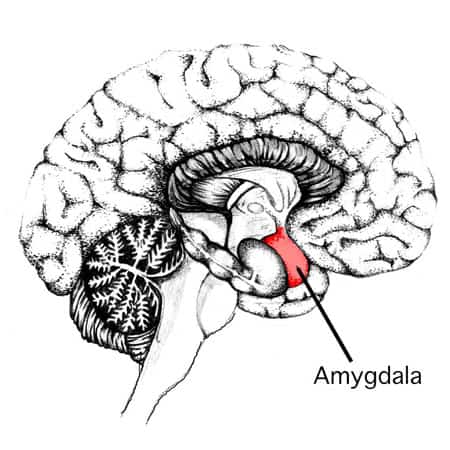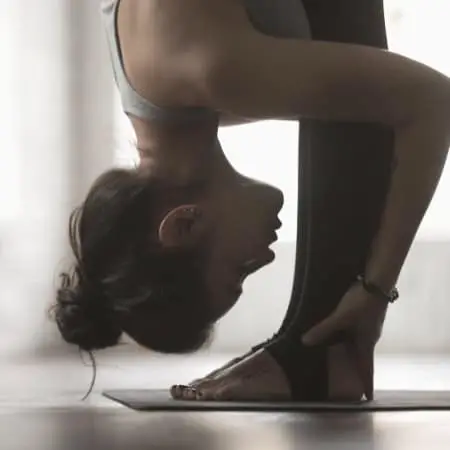As yoga has taken on global popularity, the physical asana practice has become very visible to all, even to those who do not practice yoga themselves. However, engaging in physical postures is just one part of an authentic yoga practice because when we trace yoga back to its origins, we come to understand it as the union between the mind and the body. In order to achieve this union, it is essential to develop a mindfulness practice alongside the asana practice.
Mindfulness is essential for every yogi because of its power to help achieve the ultimate goal in yoga: truly arriving in the present moment. This can lead to healthier thought patterns in the brain to help us experience more calm and joy throughout our lives, on and off the mat.
The rest of this article will explore what mindfulness is and why it is such an essential and powerful practice. We will see how it can free us from everyday mental health struggles, such as anxiety and depression. We will also see some simple exercises you can practice right away to begin your journey of bringing more mindfulness to your life whenever possible.
What Is Mindfulness?
The first thing we must understand is what this practice is. Mindfulness is simply bringing your attention to whatever is happening in the present moment. Mindfulness does not need to be practiced in complete silence or a monastery nestled in the mountains. You can be in the middle of a busy street or a stressful meeting and simply notice what information your senses are communicating to you. This is mindfulness.
In fact, many spiritual teachers use a buddha image in the middle of a fish market as a common visual example of what the practice of mindfulness can look like. Inside, you feel as the buddha, in touch with your presence in any situation, even as one with strong odors, sights, and sounds as you would experience in a busy fish market.
What Mindfulness Looks Like
Let’s take a look at a real-life example. As I sit and I write this, I can feel the experience of the keys on the tips of my fingers, I can feel my weight on the chair beneath me, I can hear a few car horns in the distance, and there is a faint smell of fresh coffee. By showing up at this moment, I am engaging with my present circumstance without judgment, without being caught up in the mind’s constant chatter.
So, we can call mindfulness simple but not necessarily easy. A common experience for most is that after a few seconds of arriving in the present moment and witnessing the current ongoings, the mind is ready to take over. Thoughts continue to flow through, hoping to entice you with one that will take you away from the present moment.
Letting Thoughts Come and Go

It can feel like the mind is a never-ending source of thoughts, all poised to lure you away from your current experience. Most of these thoughts are related to the past or the future. The stress, anger, or regret of past imperfections may tempt you away from the present moment, as can the fear of a future that cannot be known or controlled. Mindfulness encourages you to observe the thoughts floating by as you stay anchored in the current moment.
Your mind may also try to tempt you away from your current experience by seeking a judgment from you. It wants to give labels to things, marking things as good or bad, pleasant or unpleasant. Perhaps you hear a car horn in the present moment, and your mind might take the opportunity to try and create a story about how irritating the sound of traffic is.
By noticing this tendency of the mind and simply bringing awareness to it, you will be able to release that judgment as a simple thought. And one of the biggest lessons of mindfulness is that we do not have to believe our thoughts. We will have them, we can observe them, but we do not have to believe them or identify them. There is space between who we are and what our mind says.
So, what would happen if you were able to achieve that space between yourself and your thoughts? How would your life change if you were able to free yourself from the thoughts that are constantly carrying you away from the present experience? Let’s take a look at five ways that incorporating mindfulness into your life will change your experience.
A Natural Mitigation for Anxiety and Depression
When thoughts become too strong and take us down a dark spiral of distress about the unknown future or inability to let go of the past, we enter into the realm of anxiety disorders and depression.
Both anxiety and depression bring us into a loop of continuous, destructive thinking patterns. Anxiety creates severe worrying that, in a way, cannot be resolved through rational means, while depression brings us into seemingly inescapable, negative self-talk.
Recognizing Anxiety and Depression
If you are experiencing anxiety about a certain real-world issue, and you are able to resolve that issue completely, it is a very common experience for anxiety to transfer to another issue, one perhaps that wasn’t even bothering you before. Anxiety is more about a pattern of thinking than about the actual issues in someone’s life.
Depressive thoughts, on the other hand, are focused on convincing someone of his or her own worthlessness as a human being. Common thoughts associated with depression are that there is no value in their existence in this world, and there is no reason to continue living. These thoughts are only that, thoughts, but as they begin to take hold, it becomes harder and harder to break the pattern of this type of destructive thinking.
How Mindfulness Interrupts Anxious and Depressive Thinking
The good news is that practicing mindfulness is an extremely effective method to counteract the downward thinking spiral that these conditions create. At the very foundation of the practice of mindfulness is realizing that you are not your thoughts, but you can observe them without believing they are your identity. You come to have the experience of the thought and feeling as opposed to being the thought or feeling.
As waves of anxious or depressive thinking come crashing over you, by intentionally bringing yourself into the present moment, you are able to remind yourself of that separation between yourself and your negative thought patterns. They are just thoughts, and you can watch them come and go instead of believing them and becoming involved in what they are saying.
Practical Applications
Using physical anchors is a wonderful way to help yourself stay in the present moment, especially when anxious or depressive thinking feels particularly strong. Former Buddhist monk Jay Shetty gives us a way to ground ourselves in the present moment in this video:
This 5-4-3-2-1 method essentially gives our mind a task designed to bring up back into the present and out of the negative, distressing thinking loops that anxiety and depression cause us to experience. This method can even be used when having a positive experience that you want to truly feel and remember. This method will involve observing what can be perceived by each of your five senses in the present moment.
- First, notice five things that you can see. They may be ordinary things you see every day, but take a moment to really notice them.
- Second, notice four things you can touch. How do they feel?
- Next, notice three things you can hear. When was the last time you really heard the birds or that car horn?
- Now, notice two scents that you can smell. Don’t get caught up in thinking if they are pleasant or unpleasant; just witness.
- Lastly, notice one thing that you can taste.
This will help you use all of your senses to truly arrive in the present moment and create space between your true self and harmful thought patterns. Repeatedly doing this helps rewire your brain to be able to experience less anxiety and depression in the long term, so let’s look now at the science behind this benefit.
Mindfulness Can Rewire Our Brain for the Better
The more you incorporate mindfulness into your daily routine, the more benefits you will experience. This is no coincidence; the more time you repeatedly spend practicing awareness, the more your neural networks will respond and adjust for your benefit.
Typically, when left unattended, the mind is quite good at generating negative thoughts. Even for someone who does not suffer from anxiety or depression, the mind tends to generate disconcerting thoughts by default. If we do not do anything to shift this, the brain is like a muscle, building stronger and stronger neural pathways that continue to generate this same kind of thinking.
This is also the same for anxiety and depression. The more we allow our brains to engage in that type of thinking, the more it becomes practiced at it and can easily provide us with more and more of those types of thinking loops. However, as we bring in mindfulness practices, we begin to create new pathways in different parts of the brain.
How the Brain Changes Through Mindfulness
As these new pathways develop, we are able to easily arrive in the present moment and stay in that awareness. We are not as susceptible to anxiety and depression because we are giving our brains another option.
A study done at Harvard University showed, through the imaging of brain scans, that the way the patients’ brains were functioning during the mindfulness activities continued even when the individual was no longer engaged in the activity.

What the brain scans showed the researchers was related to the size of the part of the brain called the amygdala. This is the part of the brain responsible for our “fight or flight” reaction. This is the part of the brain that can make us experience panic, fear, stress, and other emotions that we may label as negative. These are typically lower levels of thinking, an area of the brain considered primal.
Interestingly, as the people in the study strengthened their mindfulness practices and the amount of time spent in awareness, their amygdalas’ size was actually reduced. Mindfulness caused the fight or flight impulse to shrink and become a less prominent reaction.
Another part of the brain, the prefrontal cortex, also experienced change based on the repeated practice of mindfulness. This part of the brain is engaged in higher-level thinking, such as concentration and the ability to make decisions. The more time spent in mindfulness, the thicker and more active this region of the brain becomes.
As the prefrontal cortex grows and the amygdala shrinks, the brain communicates more actively with the prefrontal cortex and communicates less actively with the amygdala. Over time, this creates a brain that more actively participates in high-level skills like attention and concentration and less actively participates in the primal reactions like fear and stress.
Mindfulness Is Key to Mind-Body Connection
When we trace yoga back to its roots, we see its name in Sanskrit means “union.” This is referring to the unification of the mind with the body. This can come as a surprise to the Western version of yoga, where the practice has taken on a much stronger physical emphasis. The asana practice or physical postures are certainly an integral aspect of the practice, but doing the positions alone will not bring the depth that yoga can provide.
Patanjali, a sage in ancient India who wrote the authoritative text The Yoga Sutras, gives us the key to the unification in the first word of the first sutra: atha. The meaning? Now. Through showing up to the present moment, we have access to physical and spiritual unification. A common point of entry to the present moment, especially in yoga, is by connecting to the breath as it flows in and out.
Practicing Mindfulness on the Mat

The next time you step on your yoga mat, take extra care to be aware of the present moment. You may do this by observing your breath or by observing the physical sensations of the moment. This may be to feel each of your toes on the mat, feeling your body’s weight in your seat bones, or experiencing the different sensations as your body moves through different postures.
Your mind should be moving with your body and experiencing each position and breath fully. Those are important to deepen your practice and be moving towards a unified state between your body and mind. If it has wandered off and is thinking of something far beyond the present moment, simply bring it back to the physical sensations you are currently experiencing.
Every asana is an opportunity to connect to the present moment. Every transition between postures is an opportunity to move without any automation, observe and experience how all of your physical components work together to move effortlessly. By moving slowly and with full attention, a movement you have made thousands of times can suddenly seem brand new and awe-inspiring.
Practicing Non-Judgment
One last important piece of mindfulness on the mat has to do with non-judgment. When we are fully present and simply observing thoughts, we are not getting involved with them. We are not creating more thoughts about the existing thoughts, and one way we do this is by not creating judgments of these thoughts.
It can be tempting in a yoga class, especially surrounded by others doing the same postures as you, to judge yourself against those around you. You may be tempted to tell yourself you are doing this position better than others or that you are doing it very poorly by comparison. However, if you continue to participate in this type of judgemental thinking, you are losing touch with the reason for stepping on the mat.
By practicing mindfulness and catching ourselves when we begin to engage in judgemental thinking, we are able to deepen our practice by coming back to our true selves. Our minds are likely to continue to tempt us into following thoughts, but the more we practice mindfulness, the more we are able to remain in the power of the present moment.
Mindfulness Lets You Enjoy Each Moment More Fully
When was the last time you had a meal, and the only thing that you were doing during that time was eating, chewing, and tasting? This means no tv, no internet, no phone, no distractions, and no additional stimulation. In modern life, many of us may have a hard time remembering the last meal we gave our complete attention to.
By slowing down and fully experiencing our current moment, we can experience, accept, and appreciate whatever it offers to us. A common exercise, even one that is commonly done with children, is The Raisin Exercise. This serves as an introduction to the practice of mindful eating and gives us a very concrete example of how being fully present changes our experience in the world.
Instructions for Mindful Eating
For this exercise, you do not need to use a raisin necessarily, but a small food that you can hold and that you will enjoy. You will use this food as a way to bring your full attention to your consumption of it.

First, hold the raisin between your fingers and experience how it feels there. How are its folds and textures feeling on your skin? Let your eyes explore the raisin, noticing all of its details and colors up close. You may bring it close to your nose and breath in, noticing the scent that it brings to you.
As you move your hand containing the raisin, do so slowly and intentionally, avoiding any automated movement. When you’re ready, place the raisin in your mouth. Before you swallow it up, give it a moment in your mouth and see how it feels on your tongue. Very slowly and with attention, chew your raisin and observe what happens. How is the taste? How do you feel as its sweetness is released?
As you swallow the raisin, try to keep your awareness on it for as long as possible. At what point do you feel it disappear? And once it’s gone, take a moment to reflect: how did the experience of eating the raisin with complete attention compare to the last time you ate raisins in automation? Many people will find the taste more vivid, and they experience more satisfaction to consume something with awareness.
The point of this exercise is to experience a normal activity in a fully present way. Most of us are living in automation; our legs just walk, our jaw just chews, we swallow without noticing. Doing any activity with complete attention is like it were a brand new and novel experience.
If we can move through our lives with this openness to whatever we are experiencing, we are much more able to find joy in what we once thought were mundane activities.
Your Awareness Will Positively Impact Those Around You
Eckhart Tolle, a spiritual teacher who has become well-known as the author of The Power of Now and A New Earth, writes very vividly about your internal state’s phenomenon that impacted the people around you. This is more nuanced than simply being lifted by someone in a good mood or feeling drained by interacting with someone who is currently struggling with their present moment.
In a passage in the best-selling book, A New Earth, Tolle writes:
“Every human being emanates an energy field that corresponds to his or her inner state, and most people can sense it, although they may feel someone else’s energy emanation only subliminally. It determines how you feel about and react to that person.”
The more you are able to return to the present moment, the more your internal state will be full of calm and joy. This isn’t just a positive benefit for you, but this state’s energy will be emitted to the people around you. Many of us can think of a time we were in the company of someone whose simple presence made us feel quite good. By improving our own inner state, we are able to affect those around us positively.
This also gives us a greater degree of control and responsibility for our own experience. Instead of looking to place blame on outside circumstances, we have the power in every moment to improve our internal state. The more responsibility we take for our internal state, and the more we act to improve it through mindfulness, the better we are equipped to interact with the external situations.
Additional Mindfulness Exercises to Get You Started
We have seen such exercises as the 5-4-3-2-1 Method and The Raisin Exercise through our exploration of mindfulness. Let’s take a look at a few more you can try right now to practice becoming fully present.
Three Breaths
For some, sitting for ten minutes and observing the breath may seem impossible. It is no problem to start smaller. Buddhist Monk Thich Nhat Hanh suggests taking three inhales and three exhales with complete awareness. Allow the breath to flow in through your nostrils; feel the sensation of your lungs growing with air. Notice the space between the inhale and exhale, feeling the air gently rush back out of your lungs and nostrils.
Repeat this observation for three complete breaths. Try to incorporate this exercise into your daily life whenever you can. Throughout the day at work, as you’re walking down the street, any time your breath will be there, waiting for you to observe it.
Body Scan
This is a great, adjustable exercise that you can spend several minutes doing throughout your whole body or perhaps just a minute scanning your fingers or your toes. For a full-body scan, you can begin at your toes and slowly bring your awareness up through your body until you reach the top of your head.
Alternatively, you can simply choose one body part; let’s say the right hand. Bring your attention to your thumb first, feeling the aliveness inside of your thumb without moving it. Slowly move your way through each finger and, ultimately, your palm. Move slowly and with care to sense the aliveness that is always present inside of your body.
For some guidance in completing a full-body scan, you can lay down and listen to Yoga Nidra guided meditation by Sri Sri Ravi Shankar:
Why Mindfulness is important for yogi: Final thoughts
Although it will take some practice to get used to being more mindful, this is a powerful approach to life that gives anyone access to the power of engaging with the present moment. Many of us come to yoga because we are seeking a deeper connection with our true selves and the world, and by incorporating more mindfulness into our lifestyles, we will be able to deepen our existing practice beautifully. Mindfulness can be practiced by anyone at any time and is free to all. Start your mindful practice today, and see how the benefits start to show up in your own life.




